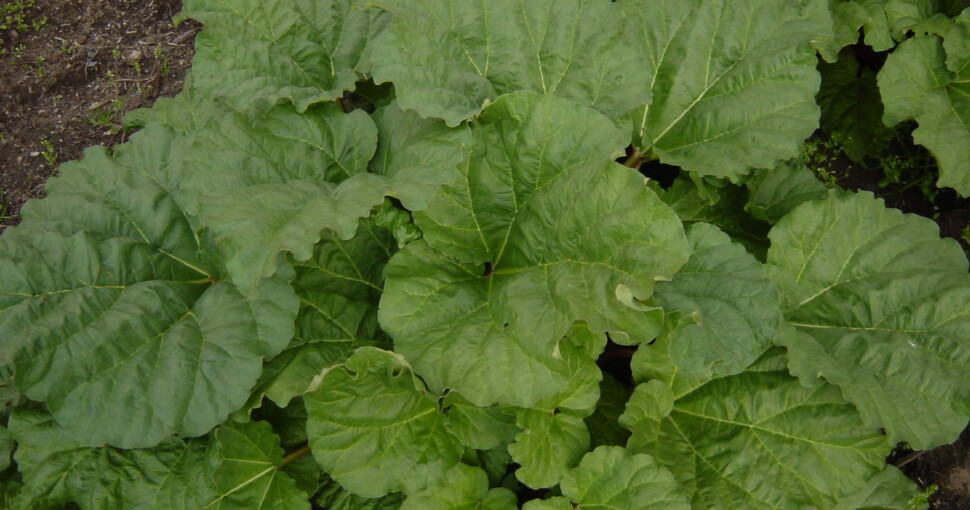Rhubarb (Rheum rhabarbarum) is a well-loved perennial plant with many benefits. The rhubarb plant originated in Asia and found its way to Europe about four hundred years ago. Rhubarbs are now found on most continents and are a favorite food plant in many gardens.
Contents
Rhubarb is not only a food plant but is also grown for its medicinal uses and cosmetic applications. There are around one hundred varieties of rhubarb available to choose from when planning to add these beautiful plants to your garden.
Rhubarb plants can grow very big, so ensure that you have enough room in the area you decide to plant it. The ideal spot for a rhubarb should be sunny and allow between two and four feet in every direction for growth. Rhubarbs need space to allow for leaves that can grow almost a foot wide and stems that can grow twelve to eighteen inches long.
It is these succulent stems that gardeners are after when growing rhubarb. The stems have a tart flavor and are used in many recipes for preserves, baked goods, and desserts. Rhubarb leaves are not used as food, as they contain oxalic acid. The leaves are excellent as much or for use in the compost pile, though.
Rhubarb plants produce best if they go into a dormancy period in winter. Dormancy requires temperatures to drop below 40 °F in the winter season. The rhubarb plant’s leaves die back during this period, but as soon as the weather warms up, this perennial sends out beautiful green or red stalks and an abundance of leaves.
When planning to grow rhubarb, you need to ensure that you have the correct plant, as several plants look similar.
1. Common Burdock Or Wild Rhubarb
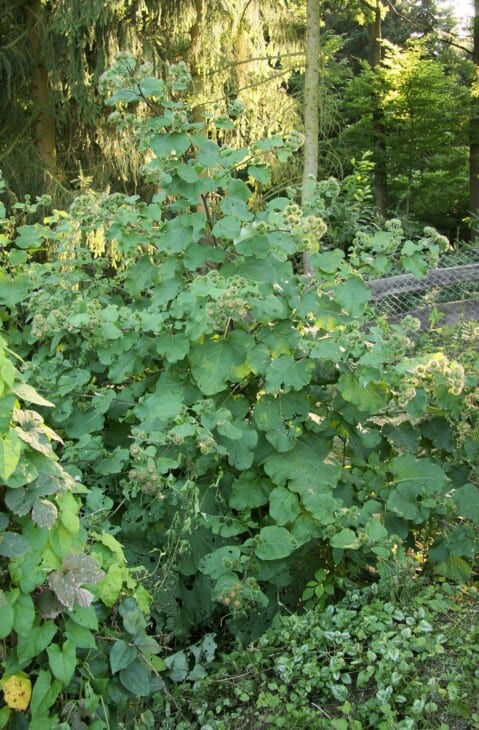
The common burdock plant (Arctium lappa) is so frequently mistaken for rhubarb that it is also called wild rhubarb. Mistaking burdock for rhubarb will likely only happen in the first year of a burdock plant’s growth. In the second year of growth, the biennial burdock plant produces purple thistle-like flowers and bur-shaped seeds to distinguish it from rhubarb.
In the first growth year, burdock has a few characteristics that set it apart from rhubarb. The easiest check to confirm identity will be the stems of the plant. Rhubarb stems are red or green and fleshy. Burdock stems may also be green or red, but they are hollow.
Burdock leaves are also large, like rhubarb but have a less wavy growth pattern on the outer edges. The leaves of rhubarb and burdock grow similarly, all from a central point or in a rosette pattern. True rhubarb leaves are smooth on the underside, while common burdock has some hairy growth on the underside of the leaf.
Related: 6 Plants That Look Like Burdock
2. Chilean Prickly Rhubarb
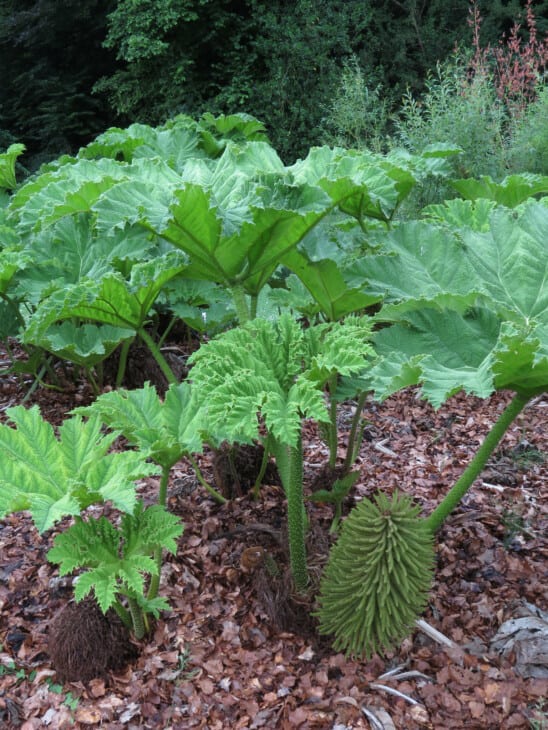
The name of prickly rhubarb (Gunnera tinctoria) is rather confusing as it is not a rhubarb at all. Prickly rhubarb is also closely related to the Brazilian giant rhubarb (Gunnera manicata). The name giant rhubarb is very accurate, as these plants grow to more than seven feet in height, and leaves can grow more than eight feet wide.
You are not likely to confuse rhubarb and prickly rhubarb for long as there are many distinguishing characteristics that differentiate these two plants. The size of new emerging leaves may look similar, but an open leaf of giant rhubarb is more than double the size of regular rhubarb.
The leaves of prickly rhubarb have spikes on the underside of the leaf and the stems. Leaves of these plants are also more lobed (or indented) than rhubarb and have a toothed edge, while rhubarb plants have a smooth edge.
Chilean rhubarb is edible. Like rhubarb, the stalks are eaten or used to make a cordial. Unlike rhubarb, the giant leaves of prickly rhubarb are also edible.
3. Indian Rhubarb
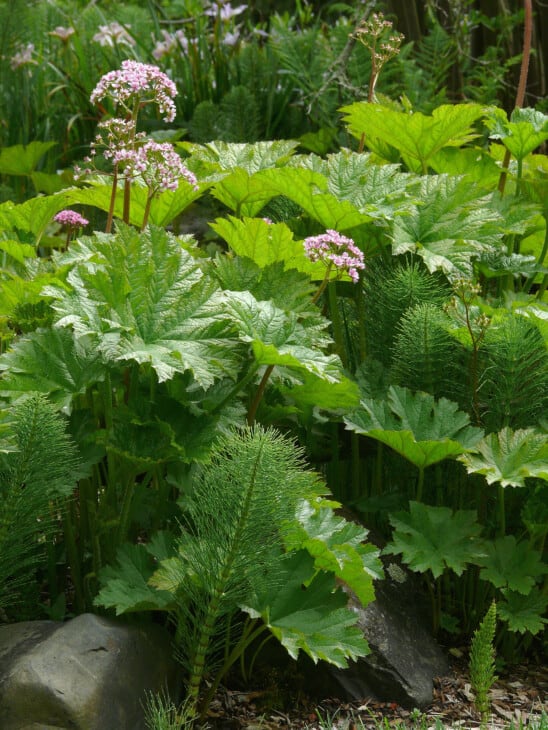
The Indian rhubarb (Darmera peltata) is also called an umbrella plant. Leaves of the Indian rhubarb develop after the flowers, so the clusters of pink flowers or flower stalks should be an easy way to tell it apart from true rhubarb.
Indian rhubarb grows best in the shade, so this is another way to tell it apart from rhubarb that thrives in full sun. While rhubarb prefers well-drained soil, Indian rhubarb thrives next to ponds and streams. A mature rhubarb plant is much smaller than an Indian rhubarb, which can grow as high as seven feet.
Indian rhubarb leaves are rounder than rhubarb and more indented with a tooth-like edge. The leaves are borne on very long leaf stems that can grow longer than six feet, giving rise to the name of the umbrella leaf. In fall, the leaves turn red, which clearly sets them apart from rhubarb.
Indian rhubarb stems are edible like rhubarb but lack the tart taste. The peeled stalks can be cooked or eaten fresh. The taste of Indian rhubarb compares to that of asparagus.
4. Canaigre Dock
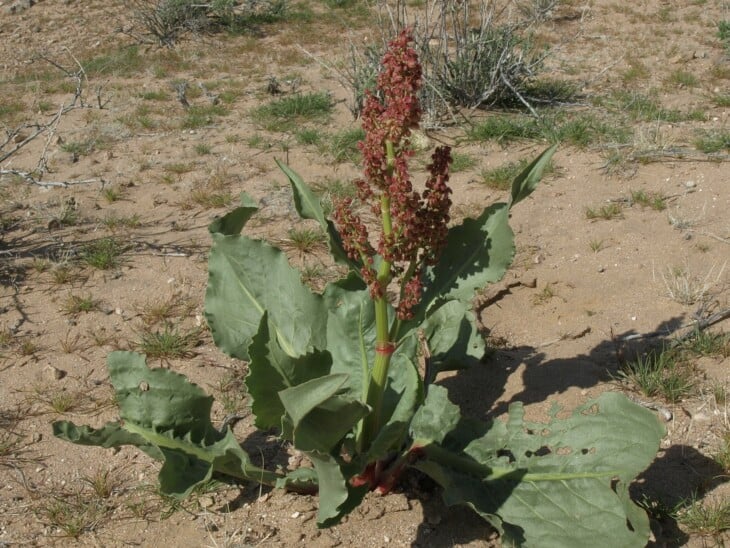
Canaigre dock or tanners’ dock (Rumex hymenosepalus) is another plant that is sometimes called wild rhubarb. In this instance, the name would not be incorrect, as these plants do belong to the same plant family as garden rhubarb.
The leaves of canaigre dock are much narrower than rhubarb, growing from one to almost five inches wide and up to ten inches long. The dock leaves have a ridge pattern that channels water or mist toward a prominent vein and down toward the root system. In this manner, the plant harvests water from its surroundings.
Canaigre dock is cultivated for leather tanning as the root has a high tannin content. The leaves and stems can be used for green, gray, or yellow fabric dye.
Similar to true rhubarb, the leaves of canaigre dock also contain oxalic acid. The concentration is not as high as in rhubarb, as this dock’s young leaves and stems are edible in small amounts. In addition to the roots’ use for tanning leather, the root has many medicinal uses that make this a popular plant.
5. Sea Dock
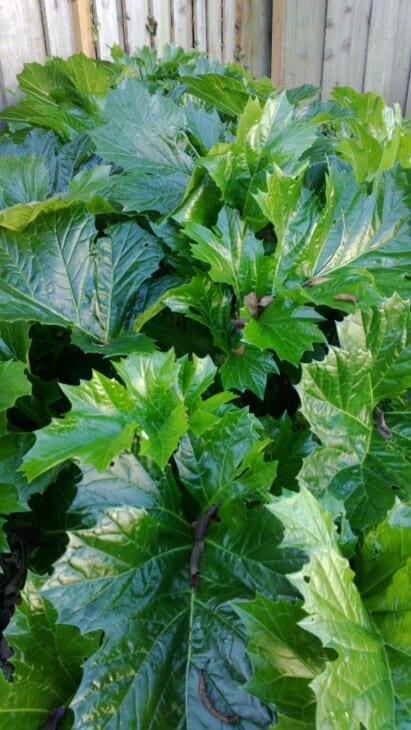
Sea dock (Acanthus mollis), or Bearsfoot, is another plant native to Europe and North Africa that has spread to many gardens worldwide. Sea cock produces large deep green leaves that can grow to twenty inches long and twelve inches wide. Like rhubarb, these leaves are produced from a central point or rosette and are carried on a leaf stem about eleven inches long.
Leaves of the sea dock plant are more elongated than those of rhubarb. The leaf structure of the sea dock is also more lobed or indented, but the leaves are hairless and shiny like rhubarb. Once the plant flowers, it is not likely to be mistaken. Sea dock produces a flower stalk almost eighty inches long with tube-like white flowers in a purple hood arranged in pairs along this stem. The flowers attract many sunbirds and insects to the garden.
Just like rhubarb, sea dock plants are perennials that grow well in full sun or partial shade. Unlike rhubarb, sea dock is not planted as an edible plant. Today sea dock is planted as an ornamental garden plant. Historically people also planted it because of its medicinal properties. Sea dock is said to be good for treating burns and healing dislocated joints.
Unlike rhubarb, sea dock contains no oxalic acid and has no adverse effects if eaten. Sea dock plants can become invasive as they spread via the rhizome system, which is very hard to contain.
It is said that the leaf of the sea dock plant was the inspiration for the leaf motif found in Greek and Roman architecture.

